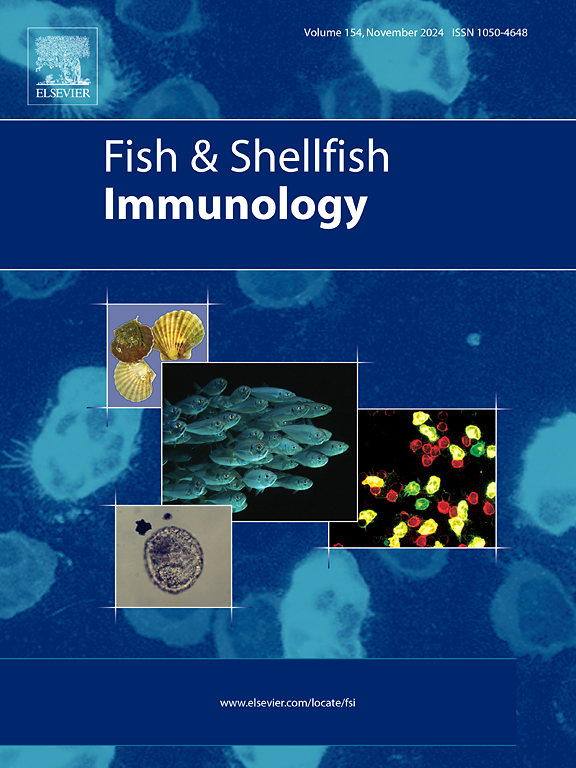单月桂酸甘油酯可提高鲤鱼的生长性能、脂质代谢和炎症反应。
IF 4.1
2区 农林科学
Q1 FISHERIES
引用次数: 0
摘要
我们进行了一项喂养试验,以研究单月桂酸甘油酯(GML)对喂养高脂饮食的鲤鱼的生长性能、脂质代谢、炎症和相关基因表达的影响。将幼年鲤鱼分养在 18 个网箱中,喂食六种等氮日粮中的一种:正常脂质日粮(对照日粮,CT)、高脂日粮(HL)和添加 0.5、1、2 和 4 g kg-1 GML 的高脂日粮(分别称为 GML-0.5、GML-1、GML-2 和 GML-4),每个处理设三个重复。饲喂 56 天后,结果表明 GML-1 和 GML-2 组的最终体重(FBW)和特定生长率(SGR)显著高于 CT、HL 和 GML-4 组(P < 0.05)。GML-1 组和 GML-2 组肝胆中的粗脂含量明显低于 HL 组(P < 0.05)。肝胰脏的形态分析表明,补充 GML 后空泡减少(P < 0.05)。此外,添加 GML 能显著促进鲤鱼肠道结构的发育。与 HL 组相比,添加 GML 会明显提高鱼片的硬度、胶质感、咀嚼感和剪切力(P < 0.05),这表明添加 GML 会明显影响鱼片的质量。此外,与 HL 组相比,GML 组生鱼片的滴水损失减少了(P < 0.05)。此外,在所有组别中,GML-1 组和 GML-2 组的血清总胆固醇水平最低(P < 0.05)。相反,补充 GML 后,血清高密度脂蛋白胆固醇(HDL)水平显著增加,其中 GML-2 组的 HDL 含量最高(P < 0.05)。与 HL 组相比,GML-1 和 GML-2 组肝胆胰脂质合成的关键基因下调,而参与脂肪分解的基因上调(P < 0.05)。对添加 GML 的鱼类肝胰脏中差异表达基因的 KEGG 功能注释分析表明,PPAR 信号通路发生了显著变化。高脂饲喂后,GML能有效提高肝胰腺、肠道、脾脏、肾脏和血清的抗氧化酶活性,同时GML-1组和GML-2组肝胰腺和肠道中的抗氧化基因显著上调。同时,与 HL 组相比,GML-1 组和 GML-2 组这些组织中的促炎因子明显下调,而抗炎因子明显上调(P < 0.05)。总之,鲤鱼饲喂添加了 1-2 g kg-1 GML 的高脂饲料后,生长性能得到改善,鱼片质量得到提高,脂质代谢得到调节,肠道结构发育得到促进,抗氧化和免疫能力得到增强。本文章由计算机程序翻译,如有差异,请以英文原文为准。
Glycerol monolaurate enhances growth performance, lipid metabolism, and inflammatory response in common carp fed high lipid diets
A feeding trial was conducted to investigate the effects of glycerol monolaurate (GML) on growth performance, lipid metabolism, inflammation, and related gene expression in common carp fed a high lipid diet. Juvenile common carp were distributed into 18 cages and fed one of six isonitrogenous diets: a normal lipid diet (control diet, CT), a high lipid diet (HL), and high lipid diets supplemented with 0.5, 1, 2, and 4 g kg−1 GML (designated as GML-0.5, GML-1, GML-2, and GML-4, respectively), with three replicates per treatment. After 56 days of feeding, the results indicated that the final body weight (FBW) and specific growth rate (SGR) in the GML-1 and GML-2 groups were significantly higher than those observed in the CT, HL, and GML-4 groups (P < 0.05). The crude lipid content in the hepatopancreas of the GML-1 and GML-2 groups was significantly lower than that in the HL group (P < 0.05). Morphological analysis of the hepatopancreas revealed a reduction in vacuole presence with GML supplementation (P < 0.05). Additionally, GML supplementation significantly enhanced the development of intestinal structures of common carp. The inclusion of GML significantly influenced the quality of the fillet, as evidenced by notable increases in hardness, gumminess, chewiness, and shear force compared to the HL group (P < 0.05). Additionally, the dripping loss of raw fillets in the GML groups decreased than that observed in the HL group (P < 0.05). Furthermore, GML-1 and GML-2 groups exhibiting the lowest serum TG levels among all groups (P < 0.05). Conversely, serum high density lipoprotein cholesterol (HDL) levels significantly increased with GML supplementation, with the GML-2 group demonstrating the highest HDL content (P < 0.05). Key genes of lipid synthesis in the hepatopancreas were down-regulated, whereas genes involved in lipolysis were up-regulated in the GML-1 and GML-2 groups relative to the HL group (P < 0.05). KEGG functional annotation analysis of differentially expressed genes in the hepatopancreas of fish fed GML-supplemented diets revealed significant alterations in the PPAR signaling pathway. GML effectively enhanced the antioxidant enzyme activities of hepatopancreas, intestine, spleen, kidney, and serum following high lipid feeding accompanied with the significant up-regulation of antioxidant genes in the hepatopancreas and intestine of the GML-1 and GML-2 groups. Simultaneously, pro-inflammatory factors in these tissues were significantly down-regulated, while anti-inflammatory factors were markedly up-regulated in the GML-1 and GML-2 groups compared to the HL group (P < 0.05). In summary, common carp fed high lipid diets supplemented with 1–2 g kg−1 GML exhibited improved growth performance, enhanced fillet quality, regulated lipid metabolism, promoted intestinal structural development, and bolstered both antioxidant and immune capacities.
求助全文
通过发布文献求助,成功后即可免费获取论文全文。
去求助
来源期刊

Fish & shellfish immunology
农林科学-海洋与淡水生物学
CiteScore
7.50
自引率
19.10%
发文量
750
审稿时长
68 days
期刊介绍:
Fish and Shellfish Immunology rapidly publishes high-quality, peer-refereed contributions in the expanding fields of fish and shellfish immunology. It presents studies on the basic mechanisms of both the specific and non-specific defense systems, the cells, tissues, and humoral factors involved, their dependence on environmental and intrinsic factors, response to pathogens, response to vaccination, and applied studies on the development of specific vaccines for use in the aquaculture industry.
 求助内容:
求助内容: 应助结果提醒方式:
应助结果提醒方式:


